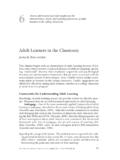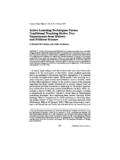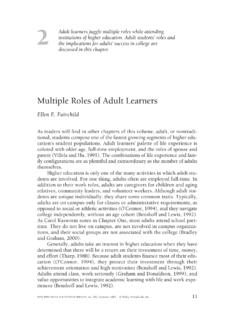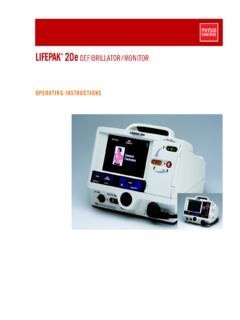Transcription of Introduction to Basic EKG Interpretation - Robert Vroman
1 Introduction to Basic EKG Interpretation Colorado State EMS ConferenceNovember 3rd 6th, 2005 Keystone, CO Robert Vroman , BS NREMT-P Properties of Cardiac Cells The cells of the heart are unique in that they have many of the properties of other muscle cells, and other properties that are found only in cardiac cells. 1. Contractility The ability of the cells to shorten and contract in response to an electrical impulse 2. Excitability The ability to respond to an electrical stimulus 3. Conductivity The ability of the cells to transmit an impulse from cell to cell rather than having to follow nervous pathways 4. Automaticity The ability of certain cardiac cells to generate their own electrical impulse, therefore they do not need to wait for an outside stimulus.
2 These cells are referred to as pacemaker cells 5. Rhythmaticity The ability of the cardiac cells to contract regularly 6. Elasticity The ability of the cardiac cells to stretch and return to their normal size and shape Cardiac Conduction _____ The intrinsic rate of the SA node is: _____ The intrinsic rate of the AV junction is: _____ The intrinsic rate of the ventricles is: _____ Other areas of the heart that can generate impulses are the: _____ Ectopic Impulse Formation Focus or Foci: _____ Ectopic: _____ Aberrant or Aberrancy: _____ Premature Complexes: _____ Escape Complexes: _____ The Electrocardiogram The electrocardiogram (ECG or EKG) represents the summary of electrical events taking place in the heart.
3 Electrodes, adhesive patches placed on the chest and attached to wires, sense the electrical activity in the heart and transform it to a digital signal which is displayed on the EKG monitor. Impulses are always displayed in their direction relative to the positive electrode. The deflection caused by impulses moving towards a positive electrode is: _____ The deflection caused by impulses moving away from a positive electrode is: _____ - + Cardiac Leads Lead I Lead III Lead II Einthoven s Triangle The Electrocardiogram (EKG) Tracing The EKG is a summary of electrical events in the heart that includes depolarization and repolarization. The EKG consists of five main parts: 1.
4 Isoelectric Line: _____ 2. Waves: _____ 3. Complexes: _____ 4. Segments: _____ 5. Intervals: _____ The EKG measures time on its horizontal axis and voltage on its vertical axis. EKG paper runs at a standard 25 mm per second. EKG paper is divided in a standard grid. Because of this and the standard speed, times and voltages can be calculated. One small box on the horizontal axis equals: _____ One large box on the horizontal axis equals: _____ One small box on the vertical axis equals: _____ One large box on the vertical axis equals: _____ Components of the Normal EKG P wave QRS complex T wave U wave P R interval QRS interval ST segment The P wave represents: _____ The QRS Complex represents: _____ The T wave represents: _____ The P R interval represents: _____ The P R interval should be between: _____ and _____ seconds The QRS interval should be less than: _____ seconds The ST segment should: _____ Six Steps to Analyze the EKG 1.
5 Determine the regularity: _____ _____ _____ _____ 2. Determine the rate: _____ _____ _____ _____ 300-150, each small block = 30 bpm 150-100, each small block = 10 bpm 100-75, each small block = 5 bpm 75-60, each small block = 3 bpm 60-50, each small block = 2 bpm 3. Determine the presence of P waves_____ _____ _____ 4. Determine the relationship of P: QRS and QRS: P: _____ _____ 5. Measure the P R interval: _____ _____ 6. Measure the QRS interval: _____ _____ Practice Rate rhythm P waves P:QRS PRI QRS Rate rhythm P waves P.
6 QRS PRI QRS Rate rhythm P waves P:QRS PRI QRS Practice Rate rhythm P waves P:QRS PRI QRS Rate rhythm P waves P:QRS PRI QRS Rate rhythm P waves P.
7 QRS PRI QRS Sinus Rhythms Normal sinus rhythm : The sinus node is the primary pacemaker of the heart, as pacemaker cells follow the rule that the fastest to repolarize will depolarize first. The rules of normal sinus rhythm are: o Rate: _____ o rhythm : _____ o P waves: _____ o P:QRS: _____ o PRI: _____ o QRS: _____ Sinus bradycardia differs from normal sinus rhythm only in that the rate is slower than what is considered normal for the sinus node. The rate for sinus bradycardia is: _____ Sinus tachycardia differs from normal sinus rhythm only in that the rate is faster than what is considered normal for the sinus node.
8 The rate for sinus tachycardia is between _____ and _____ Sinus arrhythmia differs from normal sinus rhythm only in that the rhythm is irregular, and often varies with respiration. The electrical impulse follows the same pathway as all other sinus rhythms, resulting in normal times of events. The rate of sinus arrhythmia is generally 60 100, but can vary. The rate for sinus arrhythmia may be _____ or _____ Sinus block occurs when the sinus node fires as normal, but is blocked before being transmitted to the atria, resulting in the absence of atrial depolarization noted by the absence of a P wave. A sinus block is identified when there is a pause in an otherwise normal sinus rhythm in which the rhythm picks up on its expected location following the pause.
9 The pause in sinus block is _____ Sinus arrest occurs when the sinus node does not fire, resulting in the absence of atrial depolarization noted by the absence of a P wave. A sinus arrest is identified when there is a pause in an otherwise normal sinus rhythm in which the rhythm picks up at a new location following the pause. The pause in sinus arrest is _____ Practice Rate rhythm P waves P:QRS PRI QRS Interpretation Rate rhythm P waves P.
10 QRS PRI QRS Interpretation Rate rhythm P waves P:QRS PRI QRS Interpretation Practice Rate rhythm P waves P:QRS PRI QRS Interpretation Rate rhythm P waves P:QRS PRI QRS Interpretation Rate rhythm P waves P.





